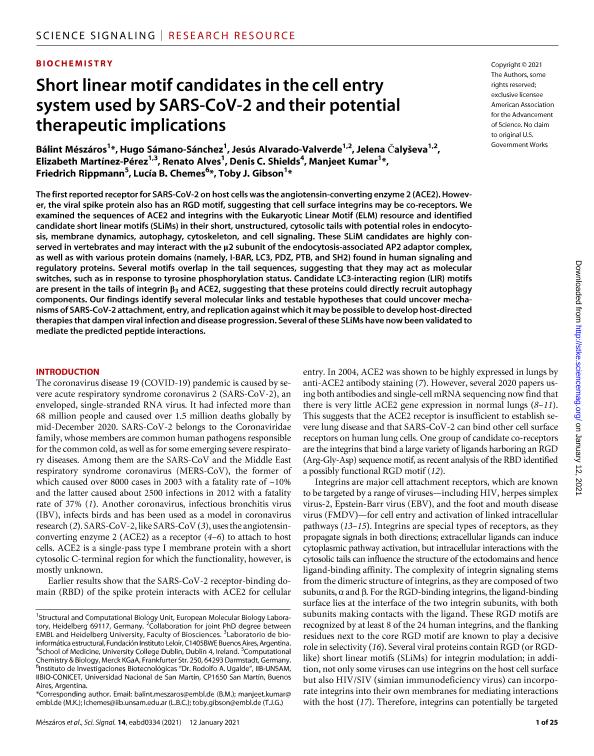Mostrar el registro sencillo del ítem
dc.contributor.author
Mészáros, Bálint

dc.contributor.author
Sámano Sánchez, Hugo

dc.contributor.author
Alvarado Valverde, Jesús

dc.contributor.author
Čalyševa, Jelena
dc.contributor.author
Martinez Perez, Elizabeth

dc.contributor.author
Alves, Renato

dc.contributor.author
Shields, Denis C.

dc.contributor.author
Kumar, Manjeet

dc.contributor.author
Rippmann, Friedrich

dc.contributor.author
Chemes, Lucia Beatriz

dc.contributor.author
Gibson, Toby James

dc.date.available
2021-07-05T22:09:58Z
dc.date.issued
2021-01-12
dc.identifier.citation
Mészáros, Bálint; Sámano Sánchez, Hugo; Alvarado Valverde, Jesús; Čalyševa, Jelena; Martinez Perez, Elizabeth; et al.; Short linear motif candidates in the cell entry system used by SARS-CoV-2 and their potential therapeutic implications; American Association for the Advancement of Science; Science Signaling; 14; 665; 12-1-2021; 1-26
dc.identifier.issn
1945-0877
dc.identifier.uri
http://hdl.handle.net/11336/135517
dc.description.abstract
The first reported receptor for SARS-CoV-2 on host cells was the angiotensin-converting enzyme 2 (ACE2). However, the viral spike protein also has an RGD motif, suggesting that cell surface integrins may be co-receptors. We examined the sequences of ACE2 and integrins with the Eukaryotic Linear Motif (ELM) resource and identified candidate short linear motifs (SLiMs) in their short, unstructured, cytosolic tails with potential roles in endocytosis, membrane dynamics, autophagy, cytoskeleton, and cell signaling. These SLiM candidates are highly conserved in vertebrates and may interact with the μ2 subunit of the endocytosis-associated AP2 adaptor complex, as well as with various protein domains (namely, I-BAR, LC3, PDZ, PTB, and SH2) found in human signaling and regulatory proteins. Several motifs overlap in the tail sequences, suggesting that they may act as molecular switches, such as in response to tyrosine phosphorylation status. Candidate LC3-interacting region (LIR) motifs are present in the tails of integrin β3 and ACE2, suggesting that these proteins could directly recruit autophagy components. Our findings identify several molecular links and testable hypotheses that could uncover mechanisms of SARS-CoV-2 attachment, entry, and replication against which it may be possible to develop host-directed therapies that dampen viral infection and disease progression. Several of these SLiMs have now been validated to mediate the predicted peptide interactions.
dc.format
application/pdf
dc.language.iso
eng
dc.publisher
American Association for the Advancement of Science

dc.rights
info:eu-repo/semantics/openAccess
dc.rights.uri
https://creativecommons.org/licenses/by-nc-sa/2.5/ar/
dc.subject
COVID-19
dc.subject
ACE2
dc.subject
INTEGRINS
dc.subject
SPIKE
dc.subject
SLIMS
dc.subject.classification
Bioquímica y Biología Molecular

dc.subject.classification
Ciencias Biológicas

dc.subject.classification
CIENCIAS NATURALES Y EXACTAS

dc.subject.classification
Epidemiología

dc.subject.classification
Ciencias de la Salud

dc.subject.classification
CIENCIAS MÉDICAS Y DE LA SALUD

dc.title
Short linear motif candidates in the cell entry system used by SARS-CoV-2 and their potential therapeutic implications
dc.type
info:eu-repo/semantics/article
dc.type
info:ar-repo/semantics/artículo
dc.type
info:eu-repo/semantics/publishedVersion
dc.date.updated
2021-07-05T18:16:48Z
dc.identifier.eissn
1937-9145
dc.journal.volume
14
dc.journal.number
665
dc.journal.pagination
1-26
dc.journal.pais
Estados Unidos

dc.description.fil
Fil: Mészáros, Bálint. European Molecular Biology Laboratory; Alemania
dc.description.fil
Fil: Sámano Sánchez, Hugo. European Molecular Biology Laboratory; Alemania
dc.description.fil
Fil: Alvarado Valverde, Jesús. European Molecular Biology Laboratory; Alemania. Ruprecht Karls Universitat Heidelberg; Alemania
dc.description.fil
Fil: Čalyševa, Jelena. European Molecular Biology Laboratory; Alemania. Ruprecht Karls Universitat Heidelberg; Alemania
dc.description.fil
Fil: Martinez Perez, Elizabeth. Fundación Instituto Leloir; Argentina. European Molecular Biology Laboratory; Alemania. Consejo Nacional de Investigaciones Científicas y Técnicas; Argentina
dc.description.fil
Fil: Alves, Renato. European Molecular Biology Laboratory; Alemania
dc.description.fil
Fil: Shields, Denis C.. Universidad de Dublin; Irlanda
dc.description.fil
Fil: Kumar, Manjeet. European Molecular Biology Laboratory; Alemania
dc.description.fil
Fil: Rippmann, Friedrich. Computational Chemistry & Biology; Alemania
dc.description.fil
Fil: Chemes, Lucia Beatriz. Consejo Nacional de Investigaciones Científicas y Técnicas. Centro Científico Tecnológico Conicet - La Plata. Instituto de Investigaciones Biotecnológicas. Universidad Nacional de San Martín. Instituto de Investigaciones Biotecnológicas; Argentina
dc.description.fil
Fil: Gibson, Toby James. European Molecular Biology Laboratory; Alemania
dc.journal.title
Science Signaling

dc.relation.alternativeid
info:eu-repo/semantics/altIdentifier/doi/http://dx.doi.org/10.1126/SCISIGNAL.ABD0334
dc.relation.alternativeid
info:eu-repo/semantics/altIdentifier/url/https://stke.sciencemag.org/content/14/665/eabd0334
Archivos asociados
